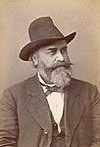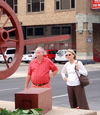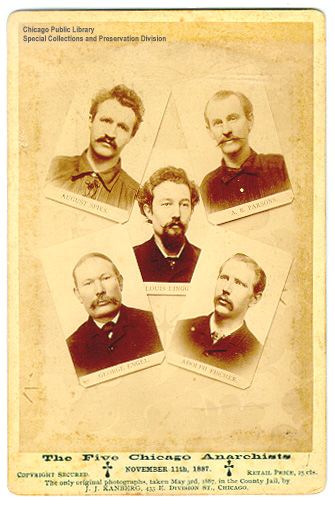 It’s a heartwarming scene that would inspire Currier & Ives or Norman Rockwell: Three generations of a Chicago clan, gathered ’round the laptop for some wholesome family entertainment. This unstaged scene, Friday night on the North Side, shows a multigenerational Brekke gathering watching JibJab’s “This Land Is Your Land” parody online. Seriously.
It’s a heartwarming scene that would inspire Currier & Ives or Norman Rockwell: Three generations of a Chicago clan, gathered ’round the laptop for some wholesome family entertainment. This unstaged scene, Friday night on the North Side, shows a multigenerational Brekke gathering watching JibJab’s “This Land Is Your Land” parody online. Seriously.
Disappointed Office-Seeker, redux
 As I mentioned in today’s post on the James A. Garfield assassination, the stock phrase used to describe his killer is “disappointed office-seeker.” Google turns up a bit that comedian Robert Klein once did based on that cliche. But Garfield wasn’t the only elected official of his era done in by someone who expected an appointment that didn’t come through.
As I mentioned in today’s post on the James A. Garfield assassination, the stock phrase used to describe his killer is “disappointed office-seeker.” Google turns up a bit that comedian Robert Klein once did based on that cliche. But Garfield wasn’t the only elected official of his era done in by someone who expected an appointment that didn’t come through.
Chicago Mayor Carter Harrison was shot to death in October 1893, the day before the scheduled closing of the World’s Columbian Exposition in the city. The killer was an apparently mentally ill man named Prendergast who believed he merited an appointment to a senior city position for services rendered to Harrison. He didn’t get the job he fancied, general counsel for the city, so he went to Harrison’s home with a gun.
Harrison was a five-term mayor (though terms were just two years in his day). His death prompted an orgy of mourning. By one account, the day of his funeral, more than half a million people lined the route to the cemetery. Later, his son, Carter Harrison II, also won five mayoral elections (so the Richards Daley were not the first to pull off that feat).
The other day, when Dad and I went down to Randolph and Desplaines streets to take a look at the new Haymarket statue, he mentioned he thought the original Haymarket sculpture, which depicts a cop trying to calm the waters of unrest, might be over in a park a few blocks to the west. We drove by, and found Union Park. On one edge is Spaulding Elementary School, where my mom’s mom, Anne O’Malley Hogan, taught back in the 1920s. We could see driving by that there was a statue in the park, but it was obscured by trees and I couldn’t see whether it was the Haymarket cop.
Dad went back down there today and called from the statue to report his findings. It’s a statue of Carter Harrison, who it turns out lived nearby when he was assassinated. (And, to connect back to Haymarket, was on the scene of the bombing before the blast took place. The Chicago Historical Society has a great writeup of the event, and Harrison’s part in it, here.)
Blog West
Back in California. Yeah, it’s a commonplace observation, but it really is amazing how far and how fast we can and do travel here, and how much we take it for granted. We think nothing of traveling across the continent, and are apt to be cross about it if anything delays us (same with this as in everything else about our lives; impatience and entitlement rule the day). Beyond the implicit sermonizing, I’ll just say it was great to see Kate and Tom when I got back on the ground in Oakland; and it was wonderful to have spent the last 10 days with Dad, Ann, Dan, Chris, Patty, Liam, Soren, Max, Ingrid, and Madeleine — in no particular order!
No pictures from the air this time — I couldn’t get a window. But more later on my trip.
WiFi: A Romance
Well, not a romance, really. But I’m sitting in my dad’s car in Evanston. I decided to check to see if there was an open node on the street before I went into S_______’s to pay to get online. Oh, yes, Evanston likes WiFi. I can see five nodes from where I’m sitting. The very first one let me on/in. The ethical and security issues involved in curbside surfing — we’ll talk about those later.
As far as the date goes, I can never see “September 17” without thinking “Antietam.” It’s an amazing place to visit. One news item: An annual vigil at the battlefield has been canceled, apparently due to Ivan-related weather.
Haymarket
Saw in the Tribune on Wednesday morning that a new statue commemorating the Haymarket Riot (more politically correct designations, such as “Haymarket Affair,” have been adopted over the years) was unveiled the day before. It’s good to see that people in Chicago will still turn out to argue the disputes of 118 years ago:
At the dedication, angry calls of “Anarchists!” were heard as Chicago Federation of Labor President Dennis Gannon read a list of men executed or sent to prison after the riot. And hecklers, some who waved anarchist flags, booed and uttered obscenities at (Fraternal Order of Police) President Mark Donahue.
Dad and I went down to Randolph and Desplaines streets — the first time I ever visited the spot. The statue’s interesting, I guess: It’s an attempt to interpret the history of the moment rather than represent it literally. (An earlier statue on the spot, of a police officer holding up his hand and saying, “In the name of the people of Illinois, I command peace,” was attacked so frequently that it has been relocated to the city’s police academy). But I’m not an art critic. More interesting to me: An older couple showed up while we were out there. After a few minutes, I asked them what had brought them out. It turned out they have retired to the city and live on Randolph, over by the lake. They had seen the story in the paper, too, and decided to investigate.  “When I read about this, I asked my kids, ‘What world-famous historical incident took place nine blocks west of where we live,” the man said. “One said, ‘It’s got somethng to do with labor.’ That was pretty good. Another one said, ‘Stop torturing your children.’ ”
“When I read about this, I asked my kids, ‘What world-famous historical incident took place nine blocks west of where we live,” the man said. “One said, ‘It’s got somethng to do with labor.’ That was pretty good. Another one said, ‘Stop torturing your children.’ ”
Dad and I visited just in time. Chicago’s late-summer warm-wave was about to break, and thunderstorms had started to move across the city; five minutes after we were back in the car, it started to rain.
Chicago Dispatch 09.10.04

Slow Friday. Beautiful end-of-summer weather here. Sitting outside at a non-Starbucks wirelessly endowed cafe on North Sheridan Road. Just about to shut things down here and walk back west to my sister’s place for dinner with her kids. Then perhaps tomorrow, Dad and I will take a little drive someplace for the weekend. Details still unsettled.
Yesterday, I went for a bike ride up along the north shore, then returned to my sister’s, then went out to the park to watch my nephew, Soren, at soccer practice. Here’s Dad and Ann, who are both taking in my niece Ingrid’s antics.
Blog East …
… or maybe Blog Midwest would be more like it. I’m headed back to Chicago this afternoon and then all over what used to be called the Northwest (and beyond) with my dad. That’s the plan, anyway; though we’ll be on the lookout for Alan Keyes trying to throw himself in front of our car to make a point about the sanctity of life. If I can figure out mobile technology, it’s possible that road reports and Keyes sightings will be logged.
Happy Birthday, Pop
Hey, it’s my dad’s birthday.
He was born up in Marshall County, Minnesota, the same year that Warren Harding became president of the United States. Who’d ever have thought we’d get a president who’d make Harding look so harmless? But enough of the politics. Although Dad was born in Warren, the county seat and where the closest hospital is, Dad’s parents (Sjur Ingebretsson Brekke and Otilia Sieversen Brekke) lived in Alvarado, where my grandfather was pastor of the Lutheran parish from about 1917 through 1925 (he had at least one other congregation he served, too, at a rural church called Kongsvinger).
The area had a certain ethnic flavor: Alvarado was half Swedish, half Norwegian back then, and started out in the late 19th century with two different congregations. Services at Kongsvinger were said in Norwegian exclusively up through the 1930s. From Alvarado, the family moved to Chicago, where Sjur had attended seminary (on the site of Wrigley Field) after arriving in the United States in 1893, age 17, and where my grandmother’s very large family lived (she was the first child in her family born in the States, in October 1884). In Chicago, my dad became fluent in English (very useful), became a Cubs fan (not so useful), met my mom (indispensable development, from my point of view), played for the Chicago Bears (tuba, in the marching band they used to have perform; I’ve been working that line for decades), worked at Spiegel’s when it really was Spiegel’s, raised a big, challenging family of his own, and has generally been a remarkable, interesting, fun guy to be around.
OK, that’s it. Happy birthday, Dad!
Sick
Well, I didn’t write yesterday. Felt flu-ish, though I wasn’t totally flattened. To break the monotony of aches. nausea and cold sweats, I spent part of the day reading “The Devil in the White City,” the best-seller that weaves together the stories of 19th century America’s most marvelous world’s fair and its most methodical serial murders, which unfolded side by side in Chicago. The book’s very good. I also pondered the cause of my brief illness — purely physical, or a combination of a bug and overwhelming Iraq crap, between the Bush-Rumsfeld post-Abu Ghraib publicity offensive and the heart-sickening murder (in Iraq) of Nicholas Berg, that poor kid from Pennsylvania.
Haymarket Square

May 4, 1886: A bomb kills 12 people (including eight police officers) during a labor rally on Chicago’s near West Side. The bomber was never caught, but police arrested eight leaders of the rally, who were subsequently convicted despite the lack of evidence tying them to the attack. A year and a half after the bombing, despite a worldwide outcry at the miscarriage of justice, four of the organizers were hanged, and one committed suicide.
Actually, I wasn’t thinking of the anniversary at all, but I saw it in a list of events for May 4 (for me, May 4 is mostly the day in 1864 U.S. Grant launched his bloody but ultimately successful campaign against Robert E. Lee’s Army of Northern Virginia). Taking a very short look around, I found a couple of great online resources about Haymarket (which resonated through Illinois and national politics for years afterward and played a role in one of my favorite historical novels, Howard Fast’s "The American," about the life of Governor John P. Altgeld). Check out the Chicago Historical Society’s detailed history of the case. Also good: The Chicago Public Library’s online Haymarket collections (from which the picture above is taken), which includes a brief writeup on the history of the famous (in Chicago) Haymarket statue memorializing the police victims of the bombing and was still attracting bombing attempts as late as 1970.

